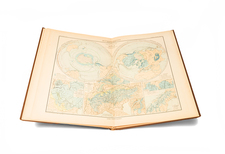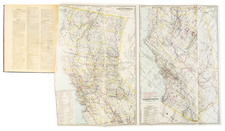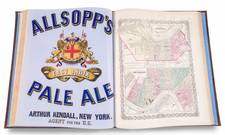A Rare American Atlas, Bound With A Rare Suite of Maps of 13 Europe
Geographische und historische Beschreibung der uberauss grosser Landtschafft America, welche auch West India und ihrer grösse halben die New Welt genennet wirt. Gar artig und nach der Kunst in XX… Mappen oder Landtaffeln verfasset und jetzt newlich in Kupffer gestochen und an Tag gegeben
The complete suite of 20 maps comprising the second atlas of the Americas. By far the rarer of only two 16th century atlases devoted to the New World. Including the extremely rare second printed map of the Pacific.
Title, plate list, and 20 double-page engraved maps with geographic commentaries in German on verso. (Wanting the additional text commentary.) Small folio, 18th century half vellum over pink paper boards.
Handsome example of one of the rarest American interest atlases ever produced. Mettelus's Geographische und historische Beschreibung der uberauss grosser Landtschafft America was one of only two atlases published in the 16th century to focus specifically on the Americas. The atlas was issued shortly after that of Cornelis Wytfliet, whose collection of maps of the Americas came out in Louvain in 1597. While Metellus's atlas went into later editions, they were all issued in, or after, 1600; the present book is the only edition which can truly claim the mantle of a 16th-century atlas of the Americas.
Nineteen of the maps in the Geographische were derived from the Wytfliet atlas. However, Metellus included one additional map from another source, basing his Pacific map on the Maris Pacifici of Abraham Ortelius. This is in fact only the second printed map to focus on the Pacific, and it is practically unobtainable as an individual map.
The general consensus is that the Flemish cartographer Cornelis Wytfliet is responsible for the first atlas of the American continents, published in Louvain in 1597. Metellus's atlas, which has extremely similar maps, was issued with the date of 1598, in Cologne.
Some prominent historians of the history of cartography have suggested that Mettelus actually predated the Wytfliet atlas. Philip Burden addressed this in his monograph on the mapping of North America, however, he dismissed it based on a comparison of the level of detail in several corresponding maps.
Jean Mattel (called Johannes Matalius Metellus), (Poligny, ca. 1517-1597), was a French jurist who spent much of his early life traveling and building a network of fellow humanists in Italy. Later Metellus moved to Louvain, notable in this case because that is where the first edition of the Wytfliet atlas was published. He made his last home in Cologne, where he became involved in that city's nascent cartographic publishing industry. His cartographic publishing career seems to have begun around 1594, when he published an atlas of France, Austria, and Switzerland, with 39 maps. Although he also contributed a description of Lyon to Braun & Hogenberg's Civitates Orbis Terrarum.
He was a friend to Matthias Quad, whose name is sometimes associated with the posthumous completion of this atlas (it was published in 1598; Metellus is thought to have died in 1597). The cartographer was also in correspondence with Abraham Ortelius. At one point he gave Ortelius assistance collating Ptolemy's Cosmography with manuscripts in the Vatican. This was evidently needed for the completion of Ortelius's Parergon Theatri. (See, H. P. Kraus, Monumenta Cartographica, items 45 and 52).
List of maps
1. Typus orbis terrarum.
"Two very similar world maps were published in Cologne in 1596 and in neither case has the author positively been identified. Attributions include the cartographer Matthias Quad, the engravers Conrad Löw or Henrich Nagel, or the publishers Lambert Andreas, Johann Bussemacher, Johan Rauw or J. Natalius Metellus. The first of these world maps is listed under Lambert Andreas, publisher of a number of topographical works in Cologne in the 1590s." (Shirley 190)
2. Limes occidentis et Quiuira Anian. Burden 121.
3. Conibas regio cum vicinis gentibus. Burden 115.
4. Estotilandia et Laboratoris Terra. Burden 116.
5. Nova Francia et Canada. Burden 117. Kershaw, page 47.
6. Norumbega et Virginia. Burden 118.
7. Florida et Apalche. Burden 119; Cumming, 20 & 23 (not realizing they are the same map); see Martin & Martin, page 75.
8. Granata nova et California. Burden 120.
9. Hispaniae Novae sivae Magnae recens et vera descriptio.
10. Lucatana regio et Fondura.
11. Cuba insula et Jamaica.
12. Hispaniola insula.
13. Castilia aurifera cum vicinis provinciis.
14. Residuum continentis cum adiacentibus insulis.
15. Brassilia.
16. Plata Americae provincia.
17. Peruani regni descriptio.
18. Chili provinci amplissima.
19. Chica sive Patagonica et Australis Terra. [Only dated map: 1598.]
20. Maris Pacificis vulgo Mar del Sur. THE SECOND PRINTED MAP DEVOTED TO THE PACIFIC. Burden 122.
Census:
NYPL; BL; JCB; Lilly; UT Austin. Only institutional copies known. Richard Arkway, Catalog 22, item 1.
The Mendel Copy. Represented for sale by Otto Lange (1936), Kenneth Nebenzahl (1960, $1250), and Parke Bernet (1962, $2000).
BOUND WITH:
LÖW, CONRAD [pseudonym of MATTHIAS QUAD.]
Königen Buch, Oder Register darin fein ordenlich erzehlt werden die Könige aller fürnehmsten Königreichen des Christenthumbs…
Cologne: L. Andree, 1598.
[2] leaves of text, 13 (of 14?) double-page engraved maps, with geographic commentary in German on verso.
An extremely rare Cologne School atlas of Europe.
Conrad Low is one of the pseudonyms of Matthias Quad, who also published anonymously. His use of pseudonyms is generally attributed to his desire to avoid backlash from his Reformed beliefs. Quad was one of the foremost cartographers of the Cologne School, which also included Georg Braun and Frans Hogenberg. According to Meurer, it is likely, "Mit hoher Wahrscheinlichkeit" that Low was the editor of Metellus's posthumous atlas. The fact that this atlas adjoins the Metellus Americas supports this hypothesis.
At the end of the 16th century and beginning of the 17th, a group of Cologne publishers and mapmakers made a concerted effort to attain relevance in the European cartographic trade. Many of the figures involved were closely associated with the Antwerp publishers who dominated the industry. Despite offering important and in some cases novel works, they failed to make a major impact, and were eventually superseded by Amsterdam and other printing centers.
List of maps (1-13 are called for in the plate list, number 14 is called for in the text of the title) :
1. Franckreich.
2. Castilia.
3. Portugallia.
4. Aragonia.
5. Engellandt.
6. Schottlandt.
7. Dennemarck.
8. Schweden.
9. Polen.
10. Ungarn.
11. Behaim.
12. Neapoli.
13. Sicilia.
14. [Lacking Turcici Imperii Descriptio, not called for in the index]
Johannes Matalius Metellus, also known as Jean Matal or Johannes Metellus Sequanas, was born in Poligny, Burgundy, France in ca. 1517. A humanist scholar, he was a polymath devoted to cartography, geography, law, paleography, and antiquarianism. Late in life he published a series of atlases; all his maps and atlases are rare and highly sought-after.
Matal was educated at Dole, Freiburg, and several Italian institutions. At Bologna, he met Antonio Agustín, a Spanish legal scholar, who recruited Matal to be his secretary. Together, the men researched ecclesiastical law, with an especial emphasis on Roman legal manuscripts, with trips to Venice, Florence, and elsewhere in Italy to study codices. In 1555, the two traveled to England to meet with Queen Mary on a mission for the Church.
After leaving his employment with Agustín, Matal traveled in the Low Countries and eventually settled in Cologne. There, he mixed with other savants, including especially Georg Cassander and Pedro Ximénez. It was in Cologne that Matal began his serious interest in mapmaking. He contributed to Braun and Hogenberg’s Civitae Orbis Terrarum; Georg Braun described him in glowing terms, “vir omni scientiarum genere praestans"—"a man outstanding in every form of knowledge."
Late in life, Matal began preparing a set of maps of the entire world. In 1594, he published an atlas of France, Austria, and Switzerland (39 maps), in 1595 an atlas of Spain (10 maps), and, posthumously, an atlas of Italy (37 maps), and one of Germany and the Netherlands (55 maps). Many of these maps were combined and augmented into atlases of Europe, Asia, Africa, the Americas, and the world’s islands. In 1602, a compendium work showcased all of these previous works called Speculum Orbis Terrae; this atlas was well received by contemporaries like Walter Raleigh and is very rare today. Many of these maps and atlases were released after his death in 1598, they were finished by his friend and fellow mapmaker Conrad Loew (Matthias Quad).












![(Atlas of France) Les Cartes Generales de Toutes les Provinces de France Reveues corrigees & augmentees par le Sr. Tassin Geographe ordinaire de sa Mageste [The General Maps of All the Provinces of France, Reviewed, Corrected, and Expanded by Mr. Tassin, Geographer to His Majesty.]](https://storage.googleapis.com/raremaps/img/small/95902.jpg)
![[ World Atlas with nearly 700 maps, views and plates ] Description de l'Univers Contenant les Differents Systèmes du Monde](https://storage.googleapis.com/raremaps/img/small/91436.jpg)

![Navigatio ac Itinerarium Iohannis Hugonis Linscotani in Orientalem Sive Lusitanorum Indiam... [Voyage and Journey of Jan Huygen van Linschoten to the Eastern, or Portuguese India...]](https://storage.googleapis.com/raremaps/img/small/93009.jpg)
